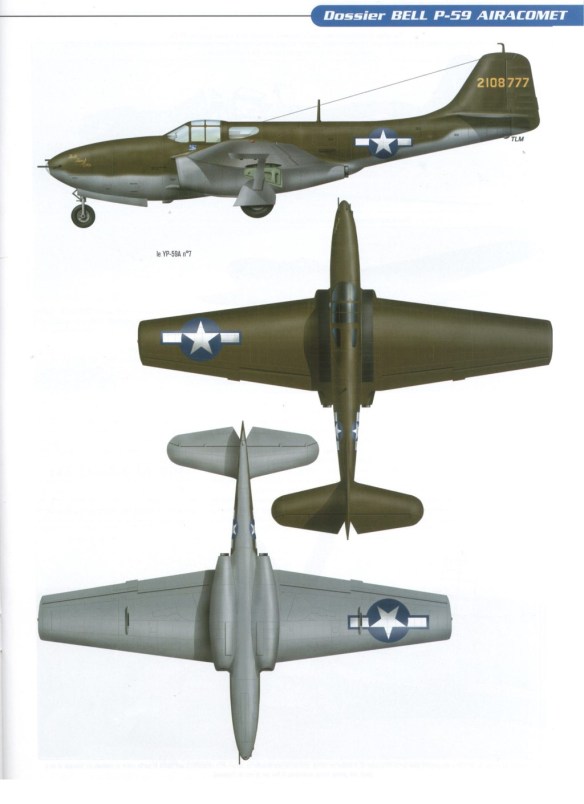The Airacomet was developed around the British Whittle Engine, Americanized and manufactured by General Electric (initial I-A produced 1,100 lbs. (500 kg) of thrust). Flight development went smoothly and deliveries of 12 YP-59As for service trials were delivered in 1944. Total procurement amounted to only 66 units including three XF2L-1 prototypes for the US Navy. It soon became apparent that the P-59’s performance did not exceed the types currently in service but would make an excellent conversion trainer.
The Bell P-59A was a fighter aircraft built in the United States during World War II. The prototype XP-59A became the first jet-powered aircraft to fly in the US on 1 October 1942.
The USAAF was not impressed by its performance and cancelled the contract when fewer than half of the aircraft ordered had been produced. Although no P-59s went into combat, it paved the way for another design generation of US turbojet-powered aircraft and was the first turbojet fighter to have its turbojet engine and inlet nacelles integrated within the main fuselage.
Design and development
Major General Henry H. Arnold became aware of the United Kingdom’s jet program when he attended a demonstration of the Gloster E.28/39 in April 1941. The subject had been mentioned, but not in depth, as part of the Tizard Mission the previously year. He requested, and was given, the plans for the aircraft’s powerplant, which he took back to the US. On 4 September, he offered General Electric a contract to produce an American version of the engine. On the following day, he approached Lawrence Bell to build a fighter to utilize it. Bell agreed and set to work on producing three prototypes. As a disinformation tactic, the USAAF gave the project the designation P-59A, to suggest it was a development of a completely unrelated Bell fighter project that had been cancelled. The design was finalized on 9 January 1942, and construction began. In March, long before the prototypes were completed, an order for 13 YP-59 pre-production machines was added to the contract.
On 12 September 1942, the first XP-59 arrived at Muroc Army Air Field (today, Edwards Air Force Base) in California for testing. While being handled on the ground, the aircraft was fitted with a dummy propeller to disguise its true nature. The aircraft first became airborne during high-speed taxiing tests on 1 October with Bell test pilot Robert Stanley at the controls, although the first official flight was made by Col Laurence Craigie the next day. Over the following months, tests on the three XP-59s revealed a multitude of problems including poor engine response and reliability (common shortcomings of all early turbojets) and performance that was far below expectations. Nevertheless, even before delivery of the YP-59s in June 1943, the USAAF ordered 80 production machines, designated P-59A Airacomet.
Operational service
The 13 service test YP-59As had a more powerful engine than its predecessor, but the improvement in performance was negligible with only a five mph increase in top speed. One of these aircraft, third YP-59A (S/n: 42-22611) was supplied to the RAF in exchange for a Gloster Meteor. British pilots found that the aircraft compared very unfavourably with the jets that they were already flying. (The YP-59A also compared unfavorably to the P-51 Mustang.) Two YP-59A Airacomets (42-108778 and 42-100779) were also delivered to the USN where they were evaluated as the YF2L-1 but quickly found completely unsuitable for carrier operations.
Faced with their own ongoing difficulties, eventually, Bell completed 50 production Airacomets-20 P-59As and 30 P-59Bs. Each was armed with one 37-mm M4 cannon and 44 rounds of ammunition and three .50 cal. machine guns and 200 rounds per gun. The P-59Bs were assigned to the 412th Fighter Group to familiarize AAF pilots with the handling and performance characteristics of jet aircraft.[1] While the P-59 was not a great success, the type did give the USAAF experience with the operation of jet aircraft in preparation for the more advanced types that would shortly become available.[2]
Survivors
The original XP-59A prototype is preserved in the Milestones of Flight Gallery of the National Air and Space Museum in Washington, DC, along with the Wright Flyer and the Apollo 11 command module Columbia. A P-59A resides in the March Field Air Museum in Riverside, California, while an example of the P-59B model is on display at the National Museum of the United States Air Force at Wright-Patterson Air Force Base near Dayton, Ohio. In 1991, the Planes of Fame Museum located in Chino, California acquired a P-59A and has been in the process of slowly restoring it to flying condition. The restoration is nearly complete and the aircraft is expected to begin appearing at air shows in summer 2006.
Operators
* United Kingdom: One in exchange for a Gloster Meteor Mk I
* United States: (US Army Air Force, US Navy)
Specifications (P-59A)
General characteristics
* Crew: 1
* Length: 38 ft 2 in (11.63 m)
* Wingspan: 45 ft 6 in (13.87 m)
* Height: 12 ft 4 in (3.76 m)
* Wing area: 386 ft² (35.9 m²)
* Empty weight: 7,940 lb (3,600 kg)
* Max takeoff weight: 12,700 lb (5,760 kg)
* Powerplant: 2× General Electric I-A turbojets, 2,800 lbf (12.5 kN) each
Performance
* Maximum speed: 413 mph (664 km/h)
* Range: 240 mi (386 km)
* Service ceiling: 46,200 ft (14,080 m)
* Rate of climb: 3,200 ft/min (16,26 m/s)
Armament
* 1x 37 mm cannon
* 3x .50 cal (12.7 mm) machine guns
